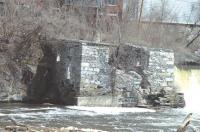
Serving the Vermont Champlain Valley Area for 45 Years
Main SectionsFront Page SportsValley VitalsIt's in the StarsStarwiseArchivesLinksAbout The VoiceContact Us |
Crumbling Foundation by Middlebury Falls All That Remains From One of the Most Imposing Buildings in the Town's History
Tuesday April 29, 2008 By Ed Barna Once upon a time, and it's no fairy tale, there was a stone building next to Middlebury Falls that stood six stories high-not including the attic. In 1811, still a time when the young United States struggled to create its own industries (Britain's policy has been to keep its colonies dependent on the home country) Major David Page decided to create a fabrics factory. It must have been a time for high hopes and great ambitions, because the place his workers built was 150 feet long, 37 feet wide, three stories high on Main Street and six stories next to the falls. By 1820, when it was owned by Joseph Hough, there were 840 spindles for cotton, 15 power looms, and two woolen carding machines. The next owner, Benjamin Marshall, brought the number of looms up to around 100 (the foregoing is from Samuel Swift's “History of the Town of Middlebury in the County of Addison, Vermont”). The looms were the key. Middlebury College professor Glenn Andres, in his “A Walking History of Middlebury,” says that the 20 power looms assembled by Joseph Gordon in 1817 from plans he had brought from Scotland were second in the country, six having been built the year before in Rhode Island. At its peak of production, under H.W. Pitts around 1850, it could put out 1,600 yards of heavy sheeting in a day, plus anywhere from 100 to 800 pounds of yarn. Thanks to the Merino sheep that a Vermonter illegally took from Spain, by 1840 Addison County had more sheep per acre and was producing more wool than any other county in the country. The Old Stone Mill downstream on the other side of Otter Creek had been created in 1813 as a cotton mill. Fire damaged it in 1825 and 1836, then in 1840 the Middlebury Manufacturing Company built it into its present form, as a place to manufacture woolen goods. But the bigger mill upstream would never participate in meeting the demand for woolen Civil War uniforms. Two fires doomed it: one in 1854, after which it was rebuilt as a flour mill; then the big one in 1891. After that, Joseph Battell bought the site, built the structures now there, and used most of the mill ruins for the foundation of the Battell Block. Today, historically minded visitors look at the remains and wonder what they could be, and local residents look and wonder what is happening inside that they can't see. From the pedestrian bridge over Otter Creek, it's possible to see people on the higher level inside the remains, but there are two levels inside, and the lower one is much harder to access. For the sake of everyone's curiosity, the Valley Voice is publishing these inside views from a recent expedition.
|
AdvertisementsSearch our Archives |
Agricultural Weather Forecast:

© 2006-18 The Valley Voice • 656 Exchange St., Middlebury, VT 05753 • 802-388-6366 • 802-388-6368 (fax)
Valleywides: [email protected] • Classifieds: [email protected] • Info: [email protected]

 Printer Friendly
Printer Friendly